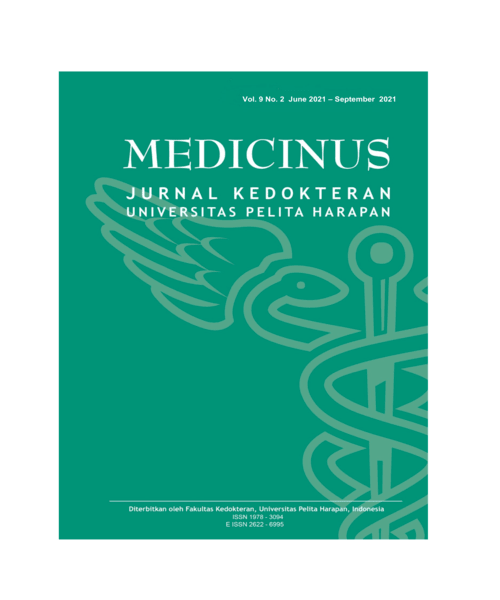Comparison of Post Operative Pain Score between Doppler-Guided Hemorrhoidal Artery Ligation and Recto Anal Repair with Open Hemorrhoidectomy on Internal Hemorrhoid Grade III-IV at Siloam Hospitals Lippo Village
DOI:
https://doi.org/10.19166/med.v9i2.4701Keywords:
Hemorrhoid, internal hemorrhoid, post-operative pain, DGHAL-RAR, hemorrhoidal artery ligation and recto anal repair, open hemorrhoidectomy, Milligan MorganAbstract
Background: Hemorrhoids are a common lesion affecting 5% of the general population. Open hemorrhoidectomy has been considered a gold standard. However, this method has a significant score of postoperative pain Because of this side effect, another alternative method to treat hemorrhoids has been invented which can reduce post-operative pain. One of these methods is doppler-guided hemorrhoidal artery ligation and rectoanal repair (DGHAL-RAR). This study aims to know the comparison of the postoperative pain score between doppler-guided hemorrhoidal artery ligation and rectoanal repair compared with open hemorrhoidectomy.
Method: The sample population of this study is internal hemorrhoid grade III-IV patients at Siloam Hospitals Lippo Village from 2018-2020. Visual analog scale data are taken from medical records. Sample data is obtained using a consecutive sampling method until 64 samples are met. The data obtained will be processed with the Mann U-Whitney test.
Results: Incidence of postoperative pain more than VAS 3 occurred in DGHAL- RAR and open hemorrhoidectomy is 81,3% and 96,9% with a p-value of 0,104. The average score of Visual Analogue Scale score in DGHAL-RAR and open hemorrhoidectomy are 1,97 and 3,13 with a p-value of 0,001.
Conclusion: This study shows that the comparison of pain scores in DGHAL-RAR and open hemorrhoidectomy is not statistically significant. The mean score of the Visual Analogue Scale Score in the DGHAL-RAR group is statistically significantly lower than the mean score in the open hemorrhoidectomy group.
References
1. Sun Z, Migaly J. Review of Hemorrhoid Disease: Presentation and Management. Clinics in Colon and Rectal Surgery 2016; 29(01): 022-029 https://doi.org/10.1055/s-0035-1568144
2. Clancy J, McVicar, A. The subjectivity of Pain. British Journal of Nursing 2016; 1: 8-12 https://doi.org/10.12968/bjon.1992.1.1.8
3. Yuksel BC, Armagan H, Berkem H, et al. Conservative management of hemorrhoids: a comparison of vagotonic flavonoid micronized purified flavonoid fraction (MPFF) and sclerotherapy. Surg Today 2008; 38:123-9. https://doi.org/10.1007/s00595-007-3582-9
4. Sneider, EB, Maykel, JA. Diagnosis and Management of Symptomatic Hemorrhoids. Surgical Clinics of North America 2010; 90(1): 17- 32. https://doi.org/10.1016/j.suc.2009.10.005
5. Fleshman J, Madoff R. Hemorrhoids. In: Cameron J, editor. Current surgical therapy 8th edition. Elsevier 2004; (245): 52.
6. Kadem SG. Short Term Outcome of Doppler Guided Hemorrhoidal Artery Ligation and Recto-Anal Repair In Comparison With Conventional Open Hemorrhoidectomy As A Treatment Method For Prolapsed Hemorrhoids. Basrah Journal Of Surgery 2017; 23: 75-81. https://doi.org/10.33762/bsurg.2017.132426
7. Sherif TM, Sarhanb AEA. Doppler”guided hemorrhoidal artery ligation with recto”anal repair versus Milligan Morgan hemorrhoidectomy for grade IV hemorrhoids. The Egyptian Journal Of Surgery 2016; 35: 155-161 https://doi.org/10.4103/1110-1121.189431
8. Shabahang H, Maddah G, Fattahi AS, Bahadorzadeh L, Noorshafiee S. Comparison of Doppler Guided Hemorrhoid Artery Ligation and Milligan Morgan Hemorrhoidectomy in Management of Hemorrhoidal Disease. Iran Red Crescent Med J. 2013; 15(5): - . https://doi.org/10.5812/ircmj.5140
Downloads
Published
How to Cite
Issue
Section
License
Copyright (c) 2021 Taufik Sudirman, Joanna Audricia Kosasih

This work is licensed under a Creative Commons Attribution-ShareAlike 4.0 International License.
Authors who publish with this journal agree to the following terms:
1) Authors retain copyright and grant the journal right of first publication with the work simultaneously licensed under a Creative Commons Attribution License (CC-BY-SA 4.0) that allows others to share the work with an acknowledgement of the work's authorship and initial publication in this journal.
2) Authors are able to enter into separate, additional contractual arrangements for the non-exclusive distribution of the journal's published version of the work (e.g., post it to an institutional repository or publish it in a book), with an acknowledgement of its initial publication in this journal.
3) Authors are permitted and encouraged to post their work online (e.g., in institutional repositories or on their website). The final published PDF should be used and bibliographic details that credit the publication in this journal should be included.





